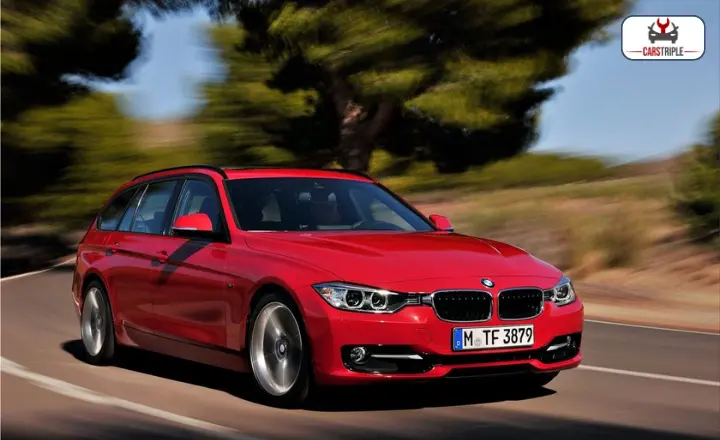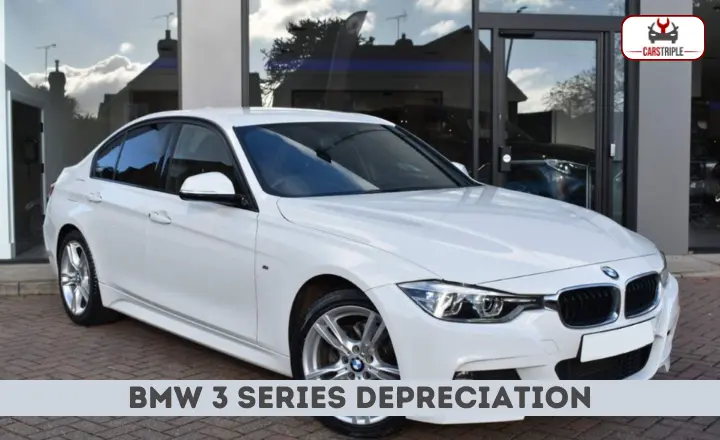Attention all thrill-seekers and car enthusiasts! We’re about to embark on an exhilarating journey through the twists and turns of BMW 3 Series depreciation rates. Strap yourself in tight because things are about to get exciting!
While driving a brand-new luxury sedan like this might make you feel like you’re on top of the world, it’s essential to understand that every joyride comes with an inevitable drop in value.
If you’re considering getting behind the wheel of a BMW 3 Series, hold onto your seats as we explore how much of your investment may disappear before your eyes.
BMW 3 Series Depreciation Rates per Year
While it may not be the most exciting topic, understanding depreciation rates can have a significant impact on your financial decisions, especially when it comes to buying a car. Turning our attention to the BMW 3 Series, one of the most popular models in the luxury sedan market, we discover some intriguing insights.
According to our analysis based on data from Auto Trader UK, a BMW 3 Series is expected to depreciate by around 17.9% in its first year alone. This means that if you were to buy a brand new model today for £30,000 ($40,000), it would lose roughly £5,370 ($7,160) in value within just twelve months.
Moving ahead three years into ownership reveals an even steeper depreciation rate of approximately 38.5%. In other words, that sleek and luxurious 320i you bought for £30k will now be worth only £18,450 ($24,600).
As time goes by and your beloved BMW ages gracefully (or not), you’ll witness the effects of this unforgiving depreciation curve more intensely. At five years old, the average depreciation rate jumps significantly to 50.2%.

The same model that once commanded admiration and turned heads might now leave you with only half its original value–£15k ($20k).
Fast forward ten years down the road and brace yourself for an astonishing depreciation rate of around 69.1%. That initial investment has dwindled down substantially; hope you enjoyed those luxurious
| Year | RRP* | Current Value | Average Mileage | Depreciation Rate | Depreciation cost |
| 2022 | £38,990 | £32,000 | 8,000 miles | 17.9% | £6,990 |
| 2021 | £38,990 | £27,000 | 17,000 miles | 30.8% | £11,990 |
| 2020 | £38,990 | £24,000 | 35,000 miles | 38.5% | £14,990 |
| 2019 | £30,100 | £17,000 | 45,000 miles | 43.5% | £13,100 |
| 2018 | £30,100 | £15,000 | 80,000 miles | 50.2% | £15,100 |
| 2017 | £26,565 | £12,000 | 100,000 miles | 54.7% | £14,565 |
| 2016 | £26,565 | £11,000 | 105,000 miles | 58.5% | £15,565 |
| 2015 | £26,565 | £10,500 | 90,000 miles | 60.4% | £16,065 |
| 2014 | £26,565 | £9,000 | 80,000 miles | 66.0% | £17,565 |
| 2013 | £25,860 | £8,000 | 95,000 miles | 69.1% | £17,860 |
| 2012 | £25,860 | £7,000 | 100,000 miles | 72.9% | £18,860 |
| 2011 | £25,465 | £5,500 | 110,000 miles | 78.4% | £19,965 |
| 2010 | £25,465 | £4,000 | 125,000 miles | 84.3% | £21,465 |
| 2009 | £25,465 | £3,000 | 110,000 miles | 88.2% | £22,465 |
| 2008 | £25,465 | £2,500 | 120,000 miles | 90.2% | £22,965 |
Which Second-Hand BMW 3 Series has the Best Value?
Buying a second-hand BMW 3 Series, one of the key factors to consider is depreciation. The value of these vehicles tends to drop significantly over time, which means you can get a great deal on a slightly older model that still offers all the benefits of a newer car. Finding the right balance between age and condition can be tricky.
Based on our, we have found that a 5-year-old model is often the sweet spot in terms of value. At this age, you can expect to pay around half of its original retail price while still enjoying many modern features and amenities. This means you can save a significant amount of money without compromising on quality.
Consider when purchasing a used BMW 3 Series is insurance costs. Owning a luxury vehicle like this may come with higher insurance premiums compared to more affordable cars.
Not all models incur the same insurance expenses, so it’s essential to do your homework before making a decision. By checking out our article on the cheapest BMW 3 Series models to insure, you can find options that offer both affordability and luxury.
Why Different BMW 3 Series Models may Depreciate Differently
It’s fascinating to understand how different factors can impact the depreciation rate of the BMW 3 Series. Not only does the body style play a role, but also the trim level and engine type.
The introduction of the GT model in 2013 created a unique dynamic as it may depreciate differently from the standard sedan version.
Comparing engines within the lineup reveals that while six-cylinder options offer better performance, they may also depreciate faster due to their higher cost and fuel consumption.
A noteworthy factor is the trim level of a BMW 3 Series. As you move up in premium trims such as Luxury or M Sport, initial costs increase along with potential depreciation over time.
It’s captivating to note that certain trim levels like the highly sought-after M Sport package can actually reduce depreciation due to their popularity on the second-hand market. Interestingly enough, despite its name implying sportiness, understanding that M Sport doesn’t signify a dedicated sports car gives us fresh insight into this aspect of driving dynamics.
Tuning plays an intriguing role in determining how a BMW 3 Series will depreciate. Depending on factors like part quality and reputation, tuning can either increase or decrease depreciation rates.
This highlights an exciting dimension where personalization choices contribute to both maintaining value or potentially impacting resale prices. It’s truly intriguing how various elements come together to shape each vehicle’s specific depreciation journey within the iconic BMW 3 Series lineup.
How Long Does a BMW 3 Series Last?
Some may associate luxury vehicles with diminishing returns and expensive maintenance costs down the line, the BMW 3 Series defies these notions by showcasing impressive longevity and retaining its value on the market.
Whether you’re looking for a car that can handle hundreds of thousands of miles or simply want reassurance that your investment won’t disappear overnight, rest assured that the BMW.
| 3 Series generation | Fuel type | Average of 5 highest-mileage cars on sale | Highest mileage |
| G20 (2019 – onwards) | Petrol | 88,640 miles (142,650 km) | 95,450 miles (153,610 km) |
| G20 (2019 – onwards) | Diesel | 104,770 miles (168,610 km) | 123,000 miles (197,950 km) |
| F30 (2012 – 2019) | Petrol | 203,600 miles (327,660 km) | 214,280 miles (344,850 km) |
| F30 (2012 – 2019) | Diesel | 199,460 miles (321,000 km) | 213,168 miles (343,060 km) |
| E90 (2005 – 2012) | Petrol | 224,980 miles (362,070 km) | 232,000 miles (373,370 km) |
| E90 (2005 – 2012) | Diesel | 216,520 miles (348,450 km) | 229,000 miles (368,540 km) |
| E46 (1998 – 2005) | Petrol | 230,220 miles (370,503 km) | 256,000 miles (411,990 km) |
| E46 (1998 – 2005) | Diesel | 177,270 miles (285,280 km) | 189,080 miles (304,290 km) |
BMW 3 Series depreciation is a common concern among owners, but there are several ways to mitigate it and extend the lifespan of your vehicle. One important tip is to keep up with regular maintenance, including oil changes, tire rotations, and brake inspections.

Smooth acceleration and braking techniques can reduce wear and tear on the engine and brakes, ultimately prolonging the life of these components. It’s also important to avoid excessive idling or aggressive driving behaviors that put unnecessary stress on the car.
taking care of the interior and exterior of your BMW 3 Series can have a significant impact on its longevity. Regularly cleaning both the interior upholstery and exterior paint will help prevent damage from dirt, debris, or corrosive substances.
Applying protective coatings such as wax or sealants can also provide an additional layer of defense against environmental elements.
By following these tips for making your 3 Series last longer, you can not only increase its lifespan but also improve its resale value if you ever decide to sell or trade it in the future.
Conclusion
The BMW 3 Series Depreciation models are significant, with over half of their original value lost within the first five years. This suggests that buying a brand-new BMW 3 Series may not be a wise financial decision.
Instead, considering a 5-year-old model with low mileage would provide the best value for money. It is clear that the age of the vehicle has a greater impact on its depreciation than its mileage. For those interested in purchasing a BMW 3 Series, these factors should be taken into consideration.
Frequently Asked Questions
Will the BMW 3 Series depreciate significantly in 2023?
While it is difficult to predict exact depreciation rates, most cars experience some level of depreciation over time.
What factors contribute to the depreciation of a BMW 3 Series?
Various factors can affect depreciation, including mileage, condition, market demand, and the introduction of new models.
Should I lease or buy a BMW 3 Series to minimize depreciation losses?
Leasing may offer lower monthly payments but results in no ownership equity. Buying allows you to own the car and potentially benefit from any value it retains.
Are certain trims or options more prone to higher levels of depreciation?
Generally, trims with higher initial costs or less popular options might experience slightly higher levels of depreciation compared to their counterparts.

